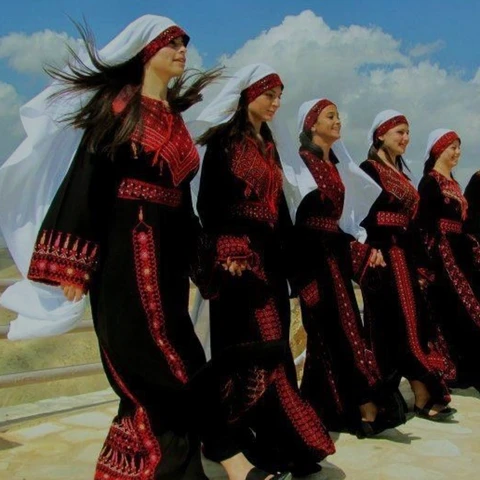From Jericho, one of the first settlements on earth, to Jerusalem, an important city for three major religions, Palestine is a country with a rich history and even more lavish culture. However, there’s more to just an outsider’s insight on the bountiful culture of Palestine. This nation – which narrowly connects Africa to Asia – has values that vary from food, to tradition, to religion and other things. Although, ever since the first world war Palestine has become known for things that it is not, instead of all the wonders that the land and it’s people hold. In this article you will be introduced to some of those characteristics of its culture.
Elaborate traditional clothing called the ‘thobe’ are the bedrock of Palestinian artistary. They are most commonly black or white dresses decorated by intricate cross-stitch geometric patterns, which are usually referred to as ‘tatreez’. It is a skill and form of art that women pass down to their daughters and it is considered an honour to wear one. In modern day, wearing a thobe to a formal occasion is considered a form of attachment and respect to the Palestinian culture. Yet what’s truly interesting about the thobe is that various cities and villages have stitched different symbolic images on their individual gowns. For example, in the city of Ramallah it is common for women to use images of flower pots and date trees in their stitching. The thobe has always been a symbol of pride for being Palestinian and the ability to make (frequently thobes are made by the women that wear them instead of being bought) a thobe is something that women would boast about.
Another significant piece of Palestinian clothing is the keffiyeh. It’s a black and white scarf with two main patterns holding great importance to the Palestinian community. The first pattern on the keffiyeh is of olive tree leaves which represent strength, resilience and perseverance. It has become increasingly popular since the 20th century as Palestinians have begun to wear it to show their solidarity with their fellow people. The second motif, the fishnet pattern, is about the Palestinian sailor’s connection with the Middetranean Sea. Before modern industrial jobs, fishing was an essential form of profit for many Palestinians, especially villagers living by the coast. That and the use of the sea to help crops grow, made the people develop profound respect for the Mediterranean Sea. The keffiyeh has always been a vital element in Palestinian culture, especially in the 20th century, for wearing it symbolizes being proud of one’s ethical identity.
If Palestine is known for something, then it’s definitely olives. Being an extremely fertile land and located by the sea, it’s the perfect place to grow various crops. Approximately half of all cultivated land in Palestine consists of olive trees, which amounts to about 10 million trees in total. Those olives are usually used to produce olive oil which is part of a standard Palestinian breakfast. Palestinian olive oil is also exported to countries all over the world, resulting in being an important source of revenue. Today, the olives have become a massively popular emblem of not just Palestine as a country, but also of it’s people’s resistance and pursuit of peace.
Once villagers joined hands and stood in lines stomping on mud when the weather ruined the roofs of their houses (to prevent rain from leaking into their homes), a traditional dance called the dabke was formed. This has continued to persist today as an essential part of Palestinian culture. The dabke is performed during all times of celebration, whether it’s upon the release of prisoners, family gatherings and such, or as a showcase of cooperation and solidarity with Palestinians all over the world. People would stand in a loose circle, holding hands and dancing to songs specifically made for the dabke. There would be a ‘Lawweeh’ – a person that would hold a handkerchief and lead the dance. The Lawweeh has to be extremely talented and light on their feet in order to do so. The dance itself consists of crossing the left foot over the right one twice as the group moves in a circle in sync with the song, which would usually be ‘Ala Dalouna’.
To conclude, Palestinians are a people that have persisted through many hardships and somehow managed to hold onto the same essential traditions and norms. Their culture is embedded with centuries of experience and resistance in every part of them and their society, as they continue to fight for peace and liberation.


